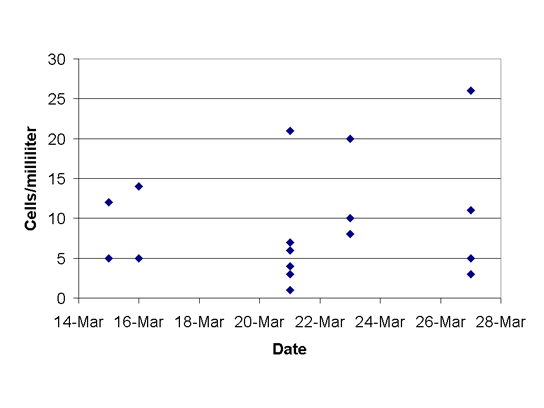|
|
The diatom Chaetoceros was widespread and abundant in the Coastal Bays last week based on water samples collected on March 21, 2006. Maryland Department of Natural Resources identified the diatom at maximum concentrations of 1,765,808 cells/milliliter in Trappe Creek and 1,589,227 cells per milliliter in Ayers Creek. Dinophysis acuminata is a dinoflagellate considered possibly toxic around the world. Maryland Department of the Environment and Department of Natural Resources have been closely tracking concentrations of this species in the Coastal Bays during March; cell counts have ranged from 1-26 cells per milliliter (Figure 1). Isle of Wight Bay at Rt. 50 Bridge measured 21 cells per milliliter on March 21 and Newport Bay on March 27 registered 26 cells per milliliter, the highest counts of the season. Monitoring of the phytoplankton community will continue to track this and other species of interest in the Coastal and Chesapeake Bays. Toxin testing in Delaware and Maryland in past years showed trace levels or no toxic activity associated with the species and cell counts of management interest in other countries. One cell per milliliter can intensify monitoring in places like Denmark and Portugal while it takes 20,000 to 50,000 cells per milliliter in Spain for considering restrictions on shellfishing). Trace amounts of okadaic acid were found in a Potomac River bloom of the Dinophysis during winter of 2002, levels were below U.S. Food and Drug Administration levels of concern for seafood health safety. Okadaic acid has been linked with Diarrhetic Shellfish Poisoning (DSP) in areas of Europe, Japan and South America. DSP is a condition associated with chills, diarrhea, abdominal cramps, nausea, and vomiting if okadaic acid-contaminated shellfish are consumed. However, no toxic outbreaks of this species have ever been identified in the area and no records are known regarding human health effects related to Dinophysis bloom waters in the United States.
Figure 1. Cell counts for Dinophysis acuminata in the Coastal Bays, March 2006. Stations were varied with each visit and include the Ocean City Inlet, bays and tributaries north and south of the inlet. |

